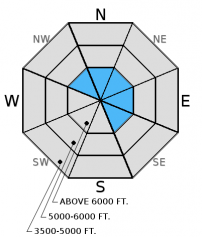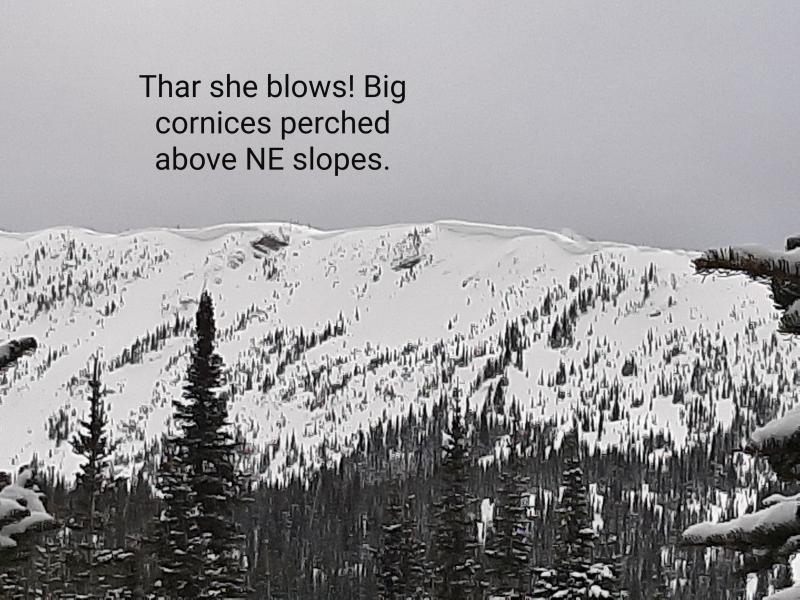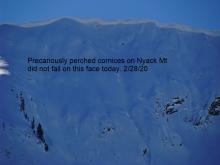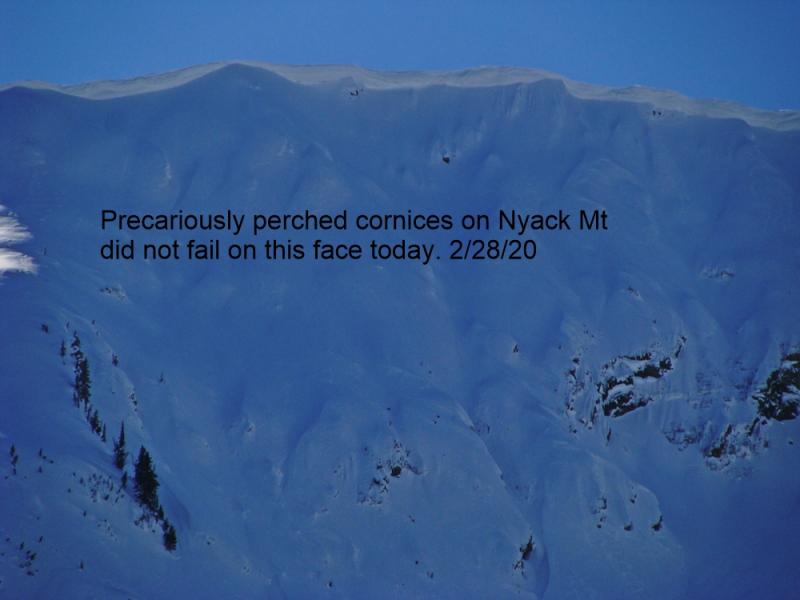| Thursday | Thursday Night | Friday | |
|---|---|---|---|
| Cloud Cover: | Scattered showers leading to clearing this evening. | Clearing. | Sunny and warm. |
| Temperatures: | 39 to 52 deg. F. | 24 to 33 deg. F. | 45 to 57 deg. F. |
| Wind Direction: | North-Northeast | Southwest | Southwest |
| Wind Speed: | 10-15 mph with gusts to 25 mph. | 5-10 mph. | 4-6 mph. |
| Snowfall: | 0 in. | 0 in. | 0 in. |
| Snow Line: |
Whitefish Range
Swan Range
Flathead Range and Glacier National Park
How to read the forecast
Wind slabs exist at upper elevations on many aspects due to recent moderate to strong winds from variable directions. Human triggered avalanches are possible. Warmer days and sunshine also bring wet snow avalanche problems. Wet loose avalanches, particularly on sunny aspects, will become an increasing hazard today. Large cornices can fail and trigger an avalanche on the slope below as well. The avalanche danger is MODERATE above 5000 feet and LOW below.

2. Moderate
?
Above 6500 ft.
2. Moderate
?
5000-6500 ft.
1. Low
?
3500-5000 ft.
- 1. Low
- 2. Moderate
- 3. Considerable
- 4. High
- 5. Extreme
-
Type ?
-
Aspect/Elevation ?

-
Likelihood ?CertainVery LikelyLikelyPossible
 Unlikely
Unlikely -
Size ?HistoricVery LargeLargeSmall

Moderate to strong winds moved from the southwest Sunday and Monday before swtiching to the north-northeast Monday night. This means you can expect both recently formed wind slabs and older, harder wind slabs on most aspects at upper elevations. Moderate to strong northeast winds, particularly near the Continental Divide, today will continue to drift recent snow into wind slabs. These slabs formed over a variety of surfaces including crusts and weaker, softer snow on more shaded aspects. On Sunday and Monday, winds moving out of the southwest formed wind slabs on the north half of the compass. We observed two small natural wind slab avalanches on a northeast aspect that likely occurred on Monday on Nyack Peak in the Flathead Range (observation). On Tuesday we observed large plumes of snow blowing off the highest ridges by strong northeast winds loading aspects on the south half of the compass this time. Pay attention to obvious signs of instability like recent avalanches and cracks shooting out from your skis or machine, and assess each slope before committing to it.
-
Type ?
-
Aspect/Elevation ?

-
Likelihood ?CertainVery LikelyLikelyPossible
 Unlikely
Unlikely -
Size ?HistoricVery LargeLargeSmall

A relatively weak refreeze overnight combined with the strength of the spring sun and above freezing temperatures can have dramatic effects on the snowpack, and conditions can change rapidly. The first signs of wet snow instability are rollerballs and pinwheels developing on a slope. This means it is time to move to a more shaded aspect. Wet, loose avalanches can entrain a fair amount of snow and knock you off your feet or machine and ruin your day. Wet loose slides have the potential to trigger wind slabs or even deeper layers in the snowpack as well.
-
Type ?
-
Aspect/Elevation ?

-
Likelihood ?CertainVery LikelyLikelyPossible
 Unlikely
Unlikely -
Size ?HistoricVery LargeLargeSmall

Warm temperatures and intense spring sun can cause cornice failure. We observed or received reports of cornice failure every week over the past 2-3 weeks with a few of them triggering avalanches on the slopes below (image). Warming temperatures today through the weekend will weaken cornices. Stay well back from the edge while traveling along ridges and minimize your time moving below them. Cornice fall can trigger wind slab avalanches and even awaken deeper instabilities in the snowpack such as the weak snow around the late February or March crusts.
Also, we observed glide cracks on numerous slopes throughout the advisory area and several have even failed (image). Glide avalanches are very difficult to predict, so the best strategy is to avoid playing on slopes where glide cracks exist.
Additional concern: You may find weak snow surrounding a series of melt-freeze and rain crusts from late February and March located 1.5 to 3 feet from the surface. These layers have not produced recent avalanches. However, digging into the snow and performing stability tests is the only way to determine if deeper weak layers exist.
Tuesday: We found 8-10 inches of snow above the melt-freeze crust from 3/25 in the Skyland area in the Flathead Range. We observed substantial wind loading from north-northeast winds along the ridges of the highest peaks. We also observed two recent natural avalanches on a northeast aspect of Nyack Mountain that likely occurred Monday 3/28 (observation). Skiers in the Wahoo/Rescue Creek area of the Flathead Range noted recent small wind slab avalanches (same ones we observed?) on north aspects along with point release activity from the previous few days (observation).
Monday: In the Skookoleel/Canyon Creek area in the southern Whitefish Range Mark found 4 inches of low density snow atop a melt-freeze crust in most locations(observation).
Sunday: Skiers in the Skiumah/Great Bear Drainages in the Flathead Range noted increasing winds as the cold front moved into the area yesterday that was actively drifting the recent snow. They triggered a small pocket of windslab from the ridge, and wisely altered their plan due to new wind slab formation (observation).
Visit our Observations page and our You Tube channel for more observations from the entire season.
Thanks to everyone for submitting observations. They are extremely useful and could help save lives.
HOW TO SUBMIT OBSERVATIONS:
Email: [email protected]
Call and leave a message: 406.387.3821
You can also submit quick observations via text: 406.241.4571 (FAC mobile)
OR
Submit Snowpack Observations: http://www.flatheadavalanche.org/node/add/snowobs
Submit Avalanche Observations: http://www.flatheadavalanche.org/node/add/avyobs
A trace to 2 inches of new snow above 5500 feet fell last night as a weak system grazed the Continental Divide from the north. Currently, temperatures above 6000 feet range from 27º-35º F, and winds are out of the north-northeast at 5-9 mph with gusts to 21 mph. Today, expect temperatures to rise into the upper 30s to upper 40s F with light winds continuing out of the north. Warm temperatures and sunshine are on tap for tomorrow.
| 0600 temperature: | 27 to 35 deg. F. |
| Max. temperature in the last 24 hours: | 34 to 48 deg. F. |
| Average wind direction during the last 24 hours: | Northeast through Northwest |
| Average wind speed during the last 24 hours: | 1-13 mph |
| Maximum wind gust in the last 24 hours: | 9-23 mph |
| New snowfall in the last 24 hours: | Trace inches |
| Total snow depth: | 85-128 inches |
This advisory applies only to backcountry areas outside established ski area boundaries. This advisory describes general avalanche conditions and local variations always occur. This advisory expires at midnight on the posted day unless otherwise noted. The information in this advisory is provided by the USDA Forest Service who is solely responsible for its content.




































